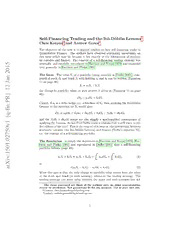
Self-Financing Trading and the Ito-Doeblin Lemma PDF
Preview Self-Financing Trading and the Ito-Doeblin Lemma
Self-Financing Trading and the Itˆo-Do¨blin Lemma1 Chris Kenyon2 and Andrew Green3 The objective of the note is to remind readers on how self-financing works in Quantitative Finance. The authors have observed continuing uncertainty on this issue which may be because it lies exactly at the intersection of stochas- tic calculus and finance. The concept of a self-financing trading strategy was 5 originally,andcarefully,introducedinHarrisonandKreps[1979]andexpanded 1 very generally in Harrison and Pliska [1981]. 0 2 The Issue The value Y of a portfolio (using notation as Duffie [2001]) com- n t posed of stock S and bond β with holding a and b can be written (Equation a t t t t J 14 on page 90): 2 Yt =atSt+btβt 1 the change in portfolio value, or gain process is given as (Equation 15 on page ] 90): R dY =a dS +b dβ t t t t t P . Clearly, ifat isadeltahedge, i.e. afunctionofSt, thenapplyingtheItˆo-D¨oblin n Lemma to the equation for Y would give: i t f - q dYt =atdSt+Stdat+datdSt+btdβt+βtdbt+dbtdβt [ and the βtdbt +dbtdβt terms are also simply a mathematical consequence of 1 applyingtheLemma. SohasProfDuffiemadeamistakethatisstillthereinthe v 3rdeditionofhistext? Thisisthecruxofthisissueattheintersectionbetween 0 5 stochastic calculus (the Itˆo-D¨oblin Lemma) and finance (Duffie’s equation 15), 7 i.e. the concept of a self-financing portfolio. 2 0 The Resolution is simply the definitions in Harrison and Kreps [1979], Har- . 1 rison and Pliska [1981] and reproduced in Duffie [2001] that a self-financing 0 portfolio follows (page 89): 5 1 (cid:90) t (cid:90) t : v atSt+btβt =a0S0+b0β0+ audSu+ btdβu (1) i 0 0 X or r a d(atSt+btβt)=atdSt+btdβt (2) What this says is that the only change in portfolio value comes from the value of the stock and bond (or cash account), whatever the trading strategy. The trading strategy can move value between the stock and cash accounts but not 1The views expressed are those of the authors only, no other representation should be attributed. Not guaranteed fit for any purpose. Use at your own risk. 2Contact: [email protected] 3Contact: [email protected] 1 create or destroy value. If this were not true then the basic result that all self- financing portfolios have the same rate of return in the risk-neutral measure would be false (Harrison and Pliska [1981]). Basically by definition of self-financing the only change in portfolio value comes from the value of the underlyings (the gain process). An additional self- financing4 equation is implied, here S da +da dS +β db +db dβ ≡ 0, but t t t t t t t t it adds nothing since it is simply a direct consequence of the definition of self- financing. However, it is irrelevant because it is the definition that drives the theory. Discussion Inshort, youcannotapplytheItˆo-D¨oblinLemmatoaportfolio’s value expressed in terms of its underlyings and get its gain process. This is by definition (Harrison and Kreps [1979], Harrison and Pliska [1981]). The definition of a self-financing trading strategy chosen by Harrison and Kreps [1979], Harrison and Pliska [1981] means that continuous time works like alimitofdiscretetimetrading. Tradingstrategiesarepredictable(nouseofthe future) and have additional technical limits (e.g. quadratic bounds), consistent with the Itˆo-D¨oblin Lemma, that rule out things like doubling strategies and other unwanted arbitrage mechanisms. Mathematicallyitispossibletochoseotherdefinitionsofself-financingfrom those chosen by Harrison and Kreps [1979], Harrison and Pliska [1981]. Then you have a different theory, and one that is not what is currently accepted, and been found useful over the last thirty or so years in Quantitative Finance. The key point delivered by the definition is that all self-financing portfolio provide the same rate of return in the risk neutral measure. If the trading strategy could change the rate of return then the theory would be broken as arbitrage opportunities would be immediate. Hence we see that the current definition of self-financing, that portfolio values changes only through its underlyings, is appropriate for Quantitative Finance. Recent modifications Kenyon and Green [2014] build on this framework, they do not contradict it. Acknowledgements TheauthorswouldliketothankProfDarrellDuffieforuse- ful pointers. Any errors remain their own. References D. Duffie. Dynamic asset pricing theory. Princeton, 2001. 3rd Edition. J.M. Harrison and D.M. Kreps. Martingales and arbitrage in multiperiod securities markets. Journal of Economic Theory, 20:381–408, 1979. J.M. Harrison and S.R. Pliska. Martingales and stochastic integrals in the theory of continuous trading. Stochastic Processes and their Applications, 11:215–260, 1981. 4Notethat“self-financingcondition”orequationisappliedtodifferentpiecesofthissetup bydifferentauthors. 2 C.KenyonandA.Green. Regulatorycostsbreakriskneutrality. Risk,27,September 2014. 3
